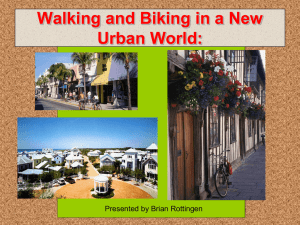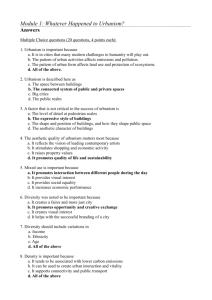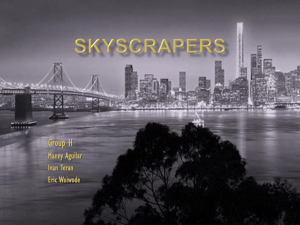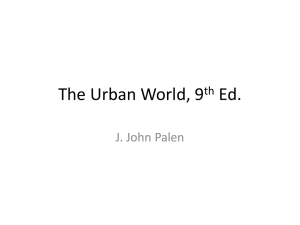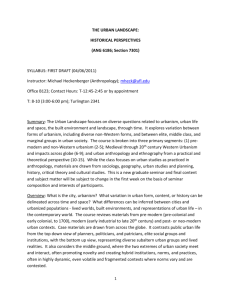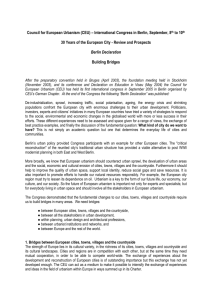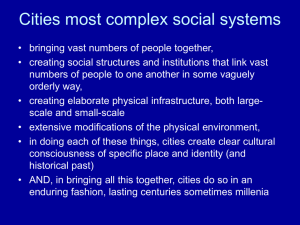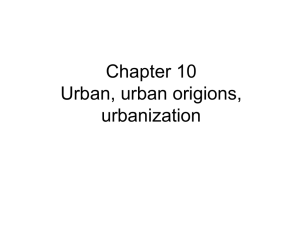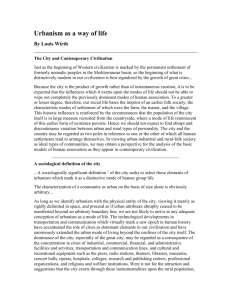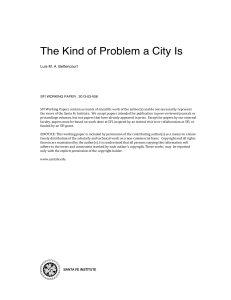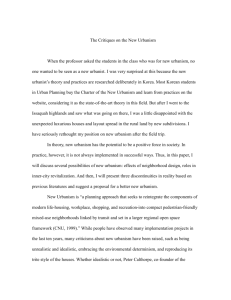PowerPoint Presentation - Computation versus memory retrieval.
advertisement
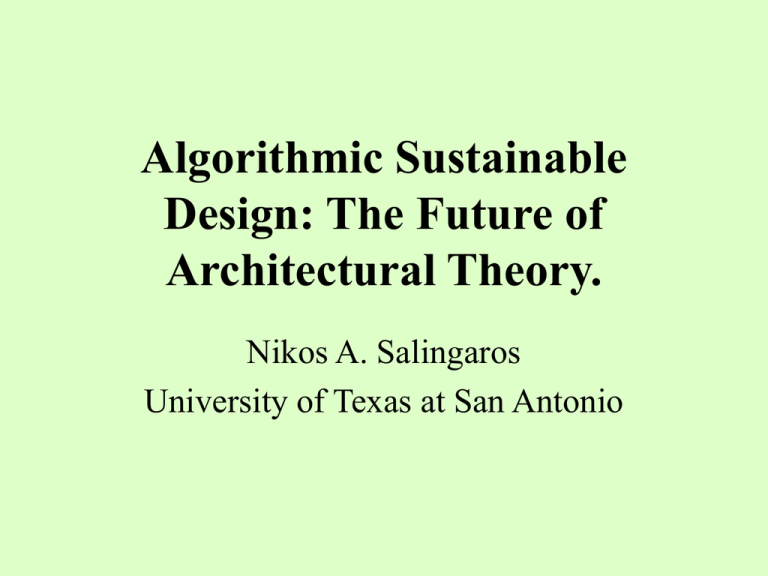
Algorithmic Sustainable Design: The Future of Architectural Theory. Nikos A. Salingaros University of Texas at San Antonio Lecture 11 A. Duany-Plater-Zyberk (DPZ) codes. B. The New Urbanism. C. Stephen Mouzon’s project. D. Tall buildings. Michael W. Mehaffy • In this lecture, I’m happy to welcome the participation of Michael Mehaffy, urbanist, philosopher, and educator • Past Director of Education for the Prince’s Foundation, London • One of Alexander’s generals: Lysimachos, Antigonos, Seleukos, Ptolemy, Mehaffy, Salingaros, et. al. Introduction (Michael) • New Urbanism is about: • The space between buildings • The arrangement of buildings in space • The complex connective system of public and private realms (including buildings!) Introduction (cont.) • Challenges: • The connective system of public and private realms is surprisingly complex! • Rapid new urbanization & growth — 50% of humanity now in cities • Environmental pressures — climate change, resource depletion, et al. Introduction (cont.) • Solutions: • Much greater urban efficiency • Much greater urban connectivity — ability to move efficiently in many modes • Self-organized patterns and patterngenerating tools — codes generate sustainable urban morphology A. Duany-Plater-Zyberk (DPZ) codes. • A practical advance in urbanism • Form-based codes unlike the ones legally binding all urban development • DPZ smart code enables organic, human-scale urban fabric to emerge • But must be calibrated to local and historical sense of place Modernist versus New Urbanist • Monoculture • Disconnected • Emphasis on largest scale • No pedestrians • Streets divide • • • • Mixed use Connected Balanced scales Protect pedestrian • Streets unify Replace all the form-based codes • Code books are modernist • They automatically produce a modernist car-dependent city • They destroy the pedestrian humanoriented and human-scaled city • The only way to reverse urban destruction is to adopt codes for traditional urbanism “Smart code” • A generic urban code that guarantees human-scale habitat • Contains many pieces that have to be calibrated for local needs • Does not force the same rigid typology everywhere • Available free online from DPZ Calibration • Measure the most wonderful examples from existing urban regions • Different typologies for different uses • Write measurements into code • Adapts to locality and different uses Transferability • Smart code is written in a legal manner, so that it can replace current codes • Switch is a purely legal matter • Very easy to do through legislation Andrés Duany’s frustration • Many prospective clients ask Andrés to do a project, but neglect to change their codes • Impossible to build human-scale environment with the existing codes • In most cases, you need to go outside city limits, where the government can relax the codes B. The New Urbanism. • In 1993, six urbanist firms got together to write the Charter for the New Urbanism • Defined rules and practices for recovering the best of traditional urbanism in today’s projects • Did not come from academia! Léon Krier’s pie Michael’s promises • The return of urbanism is the return of the civic realm • The return of urbanism is the return of the street • The human patterns come first, and then the visual ideas follow — otherwise we are simply making people live in disconnected sculptures Explosive growth • Since the initial Congress (CNU), many firms have designed neotraditional communities • Some are more adaptive than others • But new urbanist projects are getting better all the time Defines the street • Zone density in New Urbanism changes in the middle of a block, not in the middle of a road • Therefore, street on opposite sides has the same urban character • Street is the entity, not city block C. Stephen Mouzon’s project. • Schooner Bay, Bahamas, a DPZ/Urban Guild project • Stephen A. Mouzon, architect and urbanist, Miami Beach, Florida • Application of codes to project • One step at a time — Alexander Mouzon’s method • “Once the paths were set, I began designing just one building at a time, not thinking about anything that would come afterwards. I worked with no intent of artistry at all … just doing the little things that made the most sense for the site in question. Only after I had completed the block did I go back to draw the lot lines on another drawing.” Mouzon’s method (cont.) • “The character of the lots could not possibly have been designed without knowing what the buildings were, I don’t believe. This … is a technique we should have in the toolbox if you’re looking for an organic or medieval character for a place: design first, lot lines later.” The first two buildings, and the main internal paths laid out Tiny turning radii, so fix the internal chamfers Secondary internal paths beginning to develop to access the backs of the lots Block face to the left, now complete, is in the T5 zone After house on the top street was designed, the location for the path became obvious First work unit added: an office attached to the house Second and third work spaces added: a shop and an office The nearly 30-foot space saved by not having cars in paths has ENORMOUS implications Alleys for pedestrians, golf carts, and emergency vehicles only Thanks! • Unpublished diagrams from the Schooner Bay project kindly provided by Stephen Mouzon • Thanks also to DPZ and the New Urban Guild for permission to use them in this lecture D. Tall buildings. • Skyscrapers are usually designed according to a template • Ignore context and environment • Imposition of architect’s will • Can never arise from step-by-step adaptation Unsustainable • Skyscrapers can never be made sustainable • Using the latest technology does not alter their intrusive character • They introduce urban singularity Michael on skyscrapers • Claim that tall buildings are sustainable is a cruel fraud • Excessive heat gain and loss from unshaded exposures and typical glazing systems • “Heat island” effects • Require materials with very high embedded energy Michael on skyscrapers (cont.) • Skyscraper floorplates are inefficient — excessive space requirements for lifts and for emergency exit stairs • They block sun and view • Create wind effects at the ground level • Carbon benefits of urban density level off at 4 to 6 storey building envelope Social problems • Ground floor usually disconnected • Alexander’s pattern: children living more than 4 storeys from the ground feel disconnected • Léon Krier proposes tall buildings that are monuments, not residences Bad tall buildings • Iconic monsters isolated from city • Totems for worshipping some lousy architect’s ego • Built to be visually recognized • “Look at me!” — an expression of kitsch sitting in a dead plaza Religious icons • Le Corbusier’s “towers in the park” has become a religious symbol • Worshipped by modernist urbanists • Despite repeated disasters, still used as “modern” typology the world over • … with towers of ever increasing height! People never learn… Good tall buildings • • • • • • Must be very few in any city Always in the high-density center Ground floor helps urban fabric Examples from late 19C, early 20C Thin, not too tall, hierarchy of scales No setbacks Conclusion • There are several branches of New Urbanism practiced today • All of them are far better than zoned car-dependent sprawl, or skyscrapers in the park — a monstrous idea • Communities the world over are building neo-traditional developments
